Solid Waste Management in Peru’s Cities: A Clustering Approach for an Andean District
Abstract
1. Introduction
- The present study proposes to structure a set of methodological sequences to describe, quantify and segregate all organic SW generated as a product of urban consumption and design a mitigation plan.
- Using as a basis the approach developed by Kunitoshi [33], we develop a series of mitigation steps outlined in the literature that are sequentially ordered to provide a regular management policy for solid waste as proposed by MINAM.
- The focus is on the District of Santa Rosa because this high Andean area lacks resources and mitigation protocols for waste generated by urban and agricultural activities, since there is only street sweeping around parks and the market. In addition, collection is performed by trucks only in the district capital, leaving 42 communities without this service. Finally, the waste is disposed of in a dump without treatment.
- According to the results obtained in the municipal solid waste characterization study and the organic solid waste recovery pilot plan in the District of Santa Rosa, the development of a solid organic waste recovery plan to produce compost is proposed, in order to reduce the deposit of reusable waste in the municipal dump.
2. Materials and Methods
2.1. Solid Waste Characterization
- Planning. Initially, the mayoral resolution (or municipal management resolution prepared by the head of the field team) is prepared that allows maintaining the structure of the work plan together with its projections for the properties, samples, identification of these and their subsequent analysis at the end of the collection. According to the ECRS Guide, to determine the number of samples for the study, official data from INEI 2017 [37] is taken into account, which indicates that the district has 3210 homes. According to the range of household samples established by the guide for the characterization of municipal solid waste, a sample size of 94 homes is considered, to which must be added 19 contingency samples, making a total of 113 household samples (see Table 1).To determine the distribution of the samples, the guide recommends dividing the study area into 2 strata (A and B) according to the number of homes in the district, with stratum A being considered as an area with a greater number of homes and few businesses, and stratum B as an area with fewer homes and more shops (see Figure 3). In the same way, the determination of non-domestic generators was made, among them: wineries (35), restaurants (10), hostels and lodgings (4), Internet booths (2) and bakery (1) [38].The sequence of steps for the planning stage is divided into four groups. The first group authorized by the competent municipal authority is in charge of designing, approving and managing the work plan with the corresponding supervision of the documentation of logistics, administration and planning, considering precautions towards the environment. On the other hand, the sample handling procedures fall exclusively on a second team or group of helpers, associated workers and other volunteers, led by a specialist with experience in ECRS, who will be in charge of collecting solid waste in the area of study. Consequently, the analyses of the samples collected by a third group are carried out under logistical approaches that involve transport, destination areas (main and/or auxiliary), presence of managers, operators, promoters and managers of the devices or equipment to be used during the study in such a way that the objective is maintained efficiently and accurately.
- Fieldwork and operations. The solid waste sampling process stands out for the registration of residential and non-residential properties using spreadsheets for handling, assigning and analyzing samples, as well as for each agent that generates solid waste. Within this methodology, specific data are detailed, such as volume (using shaking techniques to avoid bias), homogeneous segregation and additional criteria that allow quantifying and ordering each of the values obtained. The manager responsible for the study was in charge of providing the training and assignment of functions as well as training on the use and management of safety implements and proper handling of solid waste for the entire work team. The team of the present study delivered letters of information and orientation to the owners of the homes, commercial establishments and market administrator and coordinated with the street sweeping personnel. Registers were filled with the data of sources that generate waste and classification of the participants by assigning codes. A physical space authorized by the municipality was enabled to carry out the collection, weighing and classification of the samples.Likewise, a vehicular unit was designated especially for the collection of the samples at an established time and the transfer with the corresponding precautions to be deposited in the assigned physical space, where they go through stages such as weighing each of the samples and writing them down on a file for subsequent data analysis. Subsequently, the content is emptied to separate the components, classify the materials by type, and determine the physical composition of the waste. For determination of the density, a metallic cylinder of defined volume (200 L) was conditioned, and the sample was placed in the cylinder where the density calculation was completed using formulas where the average density of solid waste was obtained [39]. This procedure was carried out for 8 days for all samples.
- Information analysis. In the estimation of waste generated per capita (GPC), calculation tools were available for each mathematical analysis involved in obtaining values according to the data and days evaluated [39,40]. For an efficient analysis, it is necessary to work with certain considerations, such as delimiting all the data in the housing number, assigned codes, number of inhabitants and GPC data, among others. The records with null values were not written as zeros but as empty cells, and thus avoiding calculations that alter the average. To determine the household generation per capita , it was necessary to know the number of inhabitants for each dwelling (289 inhabitants). Coded samples were collected for 8 consecutive days, and bag weights were noted. Performing the calculations using the formula established in RM 457-2018 Municipal Waste Characterization Guide [41], a household GPC of 0.77 kg/day was completed, and a non-household GPC of 4.37 kg/day was determined. The total generation of municipal solid waste was 3132.71 kg/day made up of domestic waste (2420.98 kg/day) and non-domestic waste (711.73 kg/day). Likewise, during the analysis of the physical composition of the solid waste of the district, it was determined that reusable waste predominated with 69.87% to 30.13% for non-usable waste of the total waste collected during the study, 222.49 kg/m3. For the determination of the density of residential solid waste, 7 days were considered, excluding day zero because it was considered unreliable data according to the guide, obtaining the result of 222.49 kg/m3, and the density for non-residential solid waste was 202 kg/day [42].
2.2. Solid Waste Valorization
- Source segregation. Prior to the valuation study, it was decided to work mainly with 2 organic SW generators: the market (30 participants) and the green areas (2 parks and 2 gardens). Additionally, there was a sporadic generator of a fair during a week in the month of August. It should be noted that these segregation establishments were previously registered, trained and sensitized for correct segregation and adequate storage of SW.
- Selective collection. Organic SW from the market was collected on Monday, Tuesday, Wednesday, Thursday and Friday. Sundays were included only for the last two months (October and November). Containers were placed at strategic points in the market for participants to deposit their waste in a coded bag; the personnel responsible for the collection weighed the samples and made the corresponding annotation in the daily records. The collection of solid organic waste from the maintenance and cleaning of the green areas of the district was on a monthly basis.
- Transport of organic solid waste. It was carried out by the trained personnel of the municipality in a truck with the enabled containers, from the district to the recovery plant located in the Simariva Population Center, Ayapampana sector, about 3.80 km. from the city.
- Treatment of organic solid waste. Once the organic solid waste arrived at the district recovery plant (total area of the plant: 12 × 9 m, concrete floor, leachate channel and tin roof), trained personnel from the municipality proceeded to remove the non-biodegradable materials (plastic, glass, metal). Then, this organic material was arranged in static piles of 3 m × 2 m with a height of 1.2 m.
- Production of organic fertilizer (compost). Organic solid waste was subjected to aerobic composting techniques and covered with plastic for 10 days. Subsequently, the batteries were removed when there was a sudden change in temperature or humidity. Once the waste had a dark color, it was dried and sieved with a 1 cm cubic sieve to pack it in bags of organic fertilizer, destined for the different green areas, as well as for the production of seedlings for forestry projects.
2.3. Methodology
2.3.1. Analysis of Variance
2.3.2. Correlation Analysis
2.3.3. Clustering Analysis
3. Results
3.1. House Analysis
3.2. Commercial Analysis
3.3. Grocery Analysis
4. Discussion
5. Conclusions
Author Contributions
Funding
Institutional Review Board Statement
Informed Consent Statement
Data Availability Statement
Conflicts of Interest
References
- Bello, H. Impact of changing lifestyle on municipal solid waste generation in residential areas: Case study of Qatar. Int. J. Waste Resour 2018, 8. [Google Scholar] [CrossRef]
- Chen, Y.C. Effects of urbanization on municipal solid waste composition. Waste Manag. 2018, 79, 828–836. [Google Scholar] [CrossRef] [PubMed]
- Daryabeigi Zand, A.; Vaeziheir, A.; Hoveidi, H. Comparative evaluation of unmitigated options for solid waste transfer stations in North East of Tehran using rapid impact assessment matrix and Iranian Leopold matrix. Environ. Energy Econ. Res. 2019, 3, 189–202. [Google Scholar]
- Song, Q.; Li, J.; Zeng, X. Minimizing the increasing solid waste through zero waste strategy. J. Clean. Prod. 2015, 104, 199–210. [Google Scholar] [CrossRef]
- Kaza, S.; Yao, L.; Bhada-Tata, P.; Van Woerden, F. What a Waste 2.0: A Global Snapshot of Solid Waste Management to 2050; World Bank Publications: Washington, DC, USA, 2018. [Google Scholar]
- Shah, A.V.; Singh, A.; Mohanty, S.S.; Srivastava, V.K.; Varjani, S. Organic solid waste: Biorefinery approach as a sustainable strategy in circular bioeconomy. Bioresour. Technol. 2022, 349, 126835. [Google Scholar] [CrossRef] [PubMed]
- Sharma, S.; Misra, S.; Singh, J. Critical review on the Solid-wastes issue: Generation, Composition, Disposal and their recycling potential for various applications. J. Phys. Conf. Ser. 2021, 1804, 012147. [Google Scholar] [CrossRef]
- Chen, D.M.C.; Bodirsky, B.L.; Krueger, T.; Mishra, A.; Popp, A. The world’s growing municipal solid waste: Trends and impacts. Environ. Res. Lett. 2020, 15, 074021. [Google Scholar] [CrossRef]
- Awasthi, M.K.; Zhao, J.; Soundari, P.G.; Kumar, S.; Chen, H.; Awasthi, S.K.; Duan, Y.; Liu, T.; Pandey, A.; Zhang, Z. Sustainable management of solid waste. In Sustainable Resource Recovery and Zero Waste Approaches; Elsevier: Amsterdam, The Netherlands, 2019; pp. 79–99. [Google Scholar]
- Deus, R.M.; Mele, F.D.; Bezerra, B.S.; Battistelle, R.A.G. A municipal solid waste indicator for environmental impact: Assessment and identification of best management practices. J. Clean. Prod. 2020, 242, 118433. [Google Scholar] [CrossRef]
- Dlamini, S.; Simatele, M.D.; Serge Kubanza, N. Municipal solid waste management in South Africa: From waste to energy recovery through waste-to-energy technologies in Johannesburg. Local Environ. 2019, 24, 249–257. [Google Scholar] [CrossRef]
- Tong, H.; Yao, Z.; Lim, J.W.; Mao, L.; Zhang, J.; Ge, T.S.; Peng, Y.H.; Wang, C.H.; Tong, Y.W. Harvest green energy through energy recovery from waste: A technology review and an assessment of Singapore. Renew. Sustain. Energy Rev. 2018, 98, 163–178. [Google Scholar] [CrossRef]
- Fetene, Y.; Addis, T.; Beyene, A.; Kloos, H. Valorisation of solid waste as key opportunity for green city development in the growing urban areas of the developing world. J. Environ. Chem. Eng. 2018, 6, 7144–7151. [Google Scholar] [CrossRef]
- Alshehrei, F.; Ameen, F. Vermicomposting: A management tool to mitigate solid waste. Saudi J. Biol. Sci. 2021, 28, 3284–3293. [Google Scholar] [CrossRef]
- Paes, L.A.B.; Bezerra, B.S.; Deus, R.M.; Jugend, D.; Battistelle, R.A.G. Organic solid waste management in a circular economy perspective–A systematic review and SWOT analysis. J. Clean. Prod. 2019, 239, 118086. [Google Scholar] [CrossRef]
- Kurniawan, T.A.; Liang, X.; O’Callaghan, E.; Goh, H.; Othman, M.H.D.; Avtar, R.; Kusworo, T.D. Transformation of solid waste management in China: Moving towards sustainability through digitalization-based circular economy. Sustainability 2022, 14, 2374. [Google Scholar] [CrossRef]
- Wang, H.; Song, J.; Ren, J.; Duan, H. Energy conversion of urban wastes in China: Insights into potentials and disparities of regional energy and environmental benefits. Energy Convers. Manag. 2019, 198, 111897. [Google Scholar] [CrossRef]
- Cai, K.; Xie, Y.; Song, Q.; Sheng, N.; Wen, Z. Identifying the status and differences between urban and rural residents’ behaviors and attitudes toward express packaging waste management in Guangdong Province, China. Sci. Total. Environ. 2021, 797, 148996. [Google Scholar] [CrossRef] [PubMed]
- Hettiarachchi, H.; Ryu, S.; Caucci, S.; Silva, R. Municipal solid waste management in Latin America and the Caribbean: Issues and potential solutions from the governance perspective. Recycling 2018, 3, 19. [Google Scholar] [CrossRef]
- Sánchez-Muñoz, M.d.P.; Cruz-Cerón, J.G.; Maldonado-Espinel, P.C. Urban solid waste management in Latin America: An analysis from the perspective of waste generation. Rev. Finanz. Polític. Econ. 2019, 11, 321–336. [Google Scholar] [CrossRef]
- Nwogwugwu, N.; Ishola, A.O. Solid waste management and public health challenges: Appraisal of local government capacity to achieve effective environmental governance. Asian Soc. Sci. 2019, 15, 1–9. [Google Scholar] [CrossRef]
- Ikhlayel, M. Development of management systems for sustainable municipal solid waste in developing countries: A systematic life cycle thinking approach. J. Clean. Prod. 2018, 180, 571–586. [Google Scholar] [CrossRef]
- Velvizhi, G.; Shanthakumar, S.; Das, B.; Pugazhendhi, A.; Priya, T.S.; Ashok, B.; Nanthagopal, K.; Vignesh, R.; Karthick, C. Biodegradable and non-biodegradable fraction of municipal solid waste for multifaceted applications through a closed loop integrated refinery platform: Paving a path towards circular economy. Sci. Total. Environ. 2020, 731, 138049. [Google Scholar] [CrossRef] [PubMed]
- Achachagua, A.J.Y. The Management Of Urban Solid Waste In Sustainable Development In A Peruvian Municipality In The Context Of The Coronavirus Pandemic (Covid-19). Turk. J. Comput. Math. Educ. 2021, 12, 3484–3489. [Google Scholar]
- Retuerto, M.G.; Espinoza, D.Y.; Andrade-Arenas, L. System Dynamics Modeling for Solid Waste Management in Lima Peru. Int. J. Adv. Comput. Sci. Appl. 2021, 12, 537–542. [Google Scholar] [CrossRef]
- Requena-Sanchez, N.; Carbonel-Ramos, D.; Moonsammy, S.; Klaus, R.; Punil, L.S.; Ng, K.T.W. Virtual Methodology for Household Waste Characterization During The Pandemic in An Urban District of Peru: Citizen Science for Waste Management. Environ. Manag. 2022, 69, 1078–1090. [Google Scholar] [CrossRef] [PubMed]
- Requena-Sanchez, N.; Carbonel-Ramos, D.; Campodónico, L.F.D. A novel methodology for household waste characterization during the COVID-19 pandemic: Case study results. J. Mater. Cycles Waste Manag. 2022, 24, 200–209. [Google Scholar] [CrossRef] [PubMed]
- Badillo-Rivera, E.; Fow-Esteves, A.; Alata-López, F.; Virú-Vásquez, P.; Medina-Acuña, M. Environmental and social analysis as risk factors for the spread of the novel coronavirus (SARS-CoV-2) using remote sensing, GIS and analytical hierarchy process (AHP): Case of Peru. MedRxiv 2020. [Google Scholar] [CrossRef]
- Vázquez-Rowe, I.; Ziegler-Rodriguez, K.; Margallo, M.; Kahhat, R.; Aldaco, R. Climate action and food security: Strategies to reduce GHG emissions from food loss and waste in emerging economies. Resour. Conserv. Recycl. 2021, 170, 105562. [Google Scholar] [CrossRef]
- Jaeger, A.; Blanchard, R. Techno-economic analysis of an enhanced anaerobic digester in the Andean area of Peru. Int. J. Energy Environ. Eng. 2022, 13, 805–819. [Google Scholar] [CrossRef]
- Marchan-Solier, C.E.; Zorrilla-Crespo, V.A.; Cardenas-Quispe, M.A.; Pacheco, A. Contaminación por Residuos Sólidos Urbanos: Caso Comunidad de Occochaca, Huanta, Perú, 2021. Sci. Res. J. CIDI 2021, 1, 1–14. [Google Scholar] [CrossRef]
- Murga Cotrina, C.J. Propuesta de Gestión de Residuos Sólidos para Sacsamarca, Ayacucho. Master’s Thesis, Pontificia Universidad Católica del Perú, San Miguel, Peru, 2017. [Google Scholar]
- Villalba, L.; Donalisio, R.S.; Basualdo, N.E.C.; Noriega, R.B. Household solid waste characterization in Tandil (Argentina): Socioeconomic, institutional, temporal and cultural aspects influencing waste quantity and composition. Resour. Conserv. Recycl. 2020, 152, 104530. [Google Scholar] [CrossRef]
- Abu Yazid, N.; Barrena, R.; Komilis, D.; Sánchez, A. Solid-state fermentation as a novel paradigm for organic waste valorization: A review. Sustainability 2017, 9, 224. [Google Scholar] [CrossRef]
- Abdel-Shafy, H.I.; Mansour, M.S. Solid waste issue: Sources, composition, disposal, recycling, and valorization. Egypt. J. Pet. 2018, 27, 1275–1290. [Google Scholar] [CrossRef]
- Veneros Urbina, B.; Amaya Alvarado, P.; Chuan Torres, Y.A.; Manchay Hernández, C. Characterization and Opportunities for the Improvement of Solid Waste at the Educational Institution, La Esperanza (Trujillo-Peru), 2019; Universidad Nacional Autonoma de Huanta: Huanta, Peru, 2020. [Google Scholar]
- INEI. Resultados Definitivos del Censo Nacional del 2017, Ayacucho, Peru; Technical Report 1023; Instituto Nacional de Estadísticas e Informática: Lima, Peru, 2018. [Google Scholar]
- Vallejo, F.; Díaz-Robles, L.; Cubillos, F.; Perez, A. Valorization of municipal solid waste using hydrothermal carbonization and gasification: A review. Chem. Eng. 2020, 81. [Google Scholar]
- Johannessen, L.M. Guidance Note on Recuperation of Landfill Gas from Municipal Solid Waste Landfills; World Bank, Urban Development Division, Urban Waste Management Thematic Group: Washington, DC, USA, 1999. [Google Scholar]
- Xiao, S.; Dong, H.; Geng, Y.; Francisco, M.J.; Pan, H.; Wu, F. An overview of the municipal solid waste management modes and innovations in Shanghai, China. Environ. Sci. Pollut. Res. 2020, 27, 29943–29953. [Google Scholar] [CrossRef]
- MINAM. Guía para la Caracterización de Residuos Sólidos Municipales; Technical Report 76; MINAM: Lima, Peru, 2018. [Google Scholar]
- Ugwu, C.O.; Ozoegwu, C.G.; Ozor, P.A. Solid waste quantification and characterization in university of Nigeria, Nsukka campus, and recommendations for sustainable management. Heliyon 2020, 6, e04255. [Google Scholar] [CrossRef] [PubMed]
- Huang, J.; Zhao, R.; Huang, T.; Wang, X.; Tseng, M.L. Sustainable municipal solid waste disposal in the belt and road initiative: A preliminary proposal for Chengdu city. Sustainability 2018, 10, 1147. [Google Scholar] [CrossRef]
- Daza, E.; Da Cruz, A.; Camargo, S.; Zavala, S.; Vargas, L.; Balbin, N. Proposal for the Management of Solid Urban Waste Generated in Naranjillo, Capital of the District of Luyando, Perú. In Proceedings of the IOP Conference Series: Earth and Environmental Science; IOP Publishing: Bristol, UK, 2022; Volume 1008, p. 012019. [Google Scholar]
- Millones, C.E.; Vásquez, E.R.; Fernandez-Güimac, S.L.; Bustamante, D.E.; Calderon, M.S. Cellulolytic and Amylolytic Bacteria with Potential for Composting Urban Solid Waste at Low Temperatures in Northern Peru. SSRN. Available online: https://ssrn.com/abstract=4239422 (accessed on 1 December 2022).
- Babu, R.; Veramendi, P.M.P.; Rene, E.R. Strategies for resource recovery from the organic fraction of municipal solid waste. Case Stud. Chem. Environ. Eng. 2021, 3, 100098. [Google Scholar] [CrossRef]
- Herrera-Murillo, J.; Rojas-Marín, J.F.; Anchía-Leitón, D. Tasas de generación y caracterización de residuos sólidos ordinarios en cuatro municipios del área metropolitana costa rica. Rev. Geográf. Amér. Cent. 2016, 2, 235–260. [Google Scholar] [CrossRef]
- Edjabou, M.E.; Møller, J.; Christensen, T.H. Solid waste characterization in Kétao, a rural town in Togo, West Africa. Waste Manag. Res. 2012, 30, 745–749. [Google Scholar] [CrossRef]
- Fereja, W.M.; Chemeda, D.D. Status, characterization, and quantification of municipal solid waste as a measure towards effective solid waste management: The case of Dilla Town, Southern Ethiopia. J. Air Waste Manag. Assoc. 2022, 72, 187–201. [Google Scholar] [CrossRef]
- Assefa, M.; Mohammed, M. Solid Waste Generation Rate and Characterization Study for Laga Tafo Laga Dadi Town, Oromia, Ethiopia. Int. J. Environ. Prot. Policy 2017, 5, 84–93. [Google Scholar] [CrossRef]
- Chaabane, W.; Nassour, A.; Nelles, M. Solid waste management key indicator development for hotels: A Tunisian case study analysis. Recycling 2018, 3, 56. [Google Scholar] [CrossRef]
- Filimonau, V.; Tochukwu, C.O. Exploring managerial approaches to mitigating solid waste in hotels of Lagos, Nigeria. J. Clean. Prod. 2020, 270, 122410. [Google Scholar] [CrossRef]
- Radwan, H.R.; Jones, E.; Minoli, D. Managing solid waste in small hotels. J. Sustain. Tour. 2010, 18, 175–190. [Google Scholar] [CrossRef]
- Mbasera, M.; Du Plessis, E.; Saayman, M.; Kruger, M. Environmentally-friendly practices in hotels. Acta Commer. 2016, 16, 1–8. [Google Scholar] [CrossRef]
- Tsai, F.M.; Bui, T.D.; Tseng, M.L.; Lim, M.K.; Hu, J. Municipal solid waste management in a circular economy: A data-driven bibliometric analysis. J. Clean. Prod. 2020, 275, 124132. [Google Scholar] [CrossRef]
- Munguía, N.E.; Díaz, Á.M.; Velazquez, L.E.; Perez, R.; Esquer, J.; Zepeda, D.S. Valorization of solid waste recovery in an institution of higher education. Green Sustain. Chem. 2018, 8, 180. [Google Scholar] [CrossRef]
- Ulfe, M.E. Danzando en Ayacucho: Música y Ritual del Rincón de los Muertos; Pontificia Universidad Católica del Perú, Instituto Riva-Agüero: San Miguel, Peru, 2004. [Google Scholar]
- Manyavilca Bendez, E. El Juego Cooperativo para el Desarrollo de Las Habilidades Sociales en Estudiantes de 3 Años del Nivel Inicial de la Institución Educativa Santa Rosa Distrito de San Miguel Provincia de la Mar región de Ayacucho en el Año Académico 2018; Universidad Catolica Los Angeles Chimbote: Chimbote, Peru, 2018. [Google Scholar]
- Essaidi, L. How can the City of Querétaro in Mexico Adopt a More Sustainable Solid Waste Management System from an Economical and Environmental Standpoint? Ph.D. Thesis, Haute École de Gestion de Genève, Geneva, Switzerland, 2020. [Google Scholar]
- Buenrostro, O.; Bocco, G. Solid waste management in municipalities in Mexico: Goals and perspectives. Resour. Conserv. Recycl. 2003, 39, 251–263. [Google Scholar] [CrossRef]
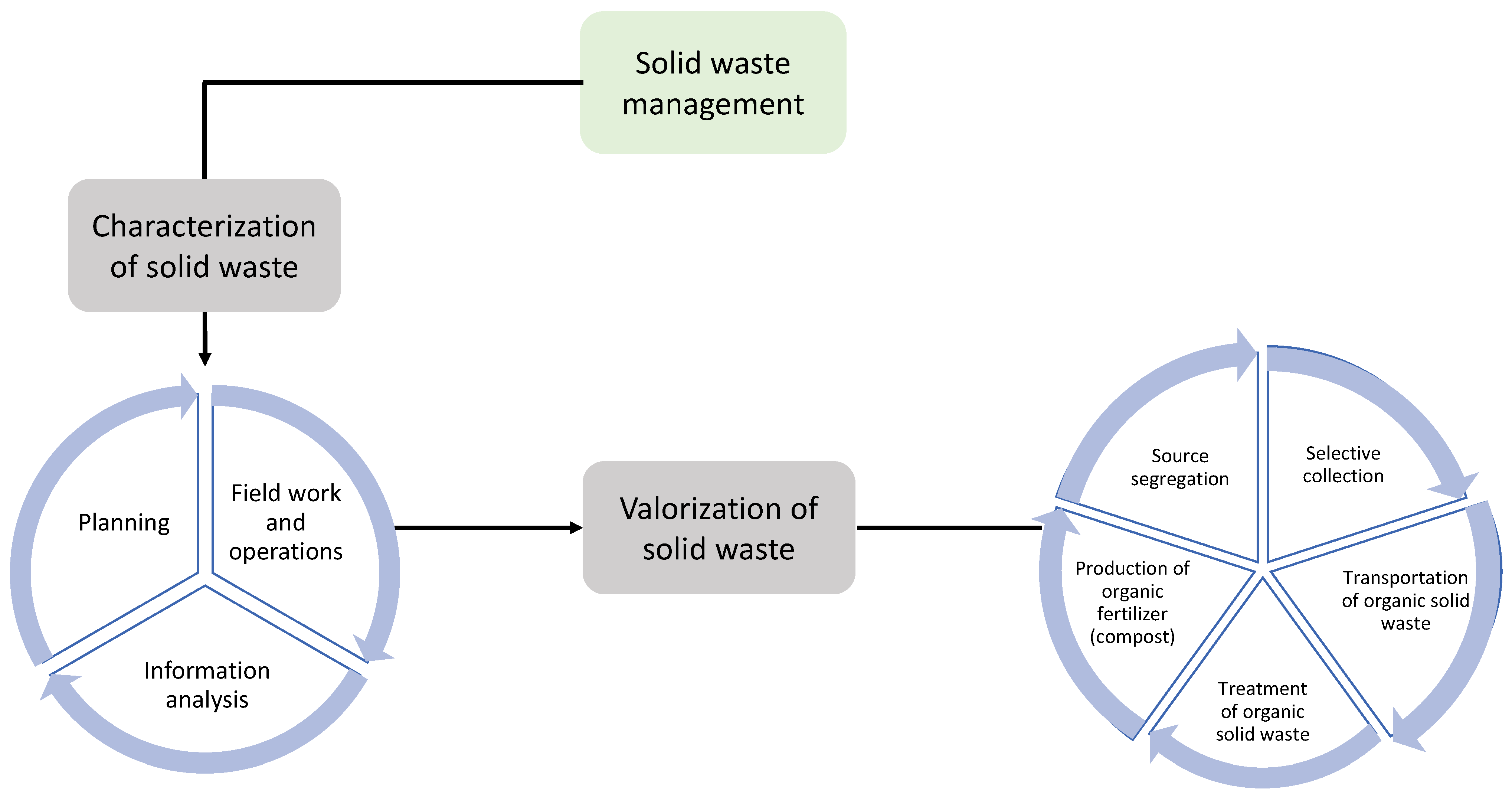

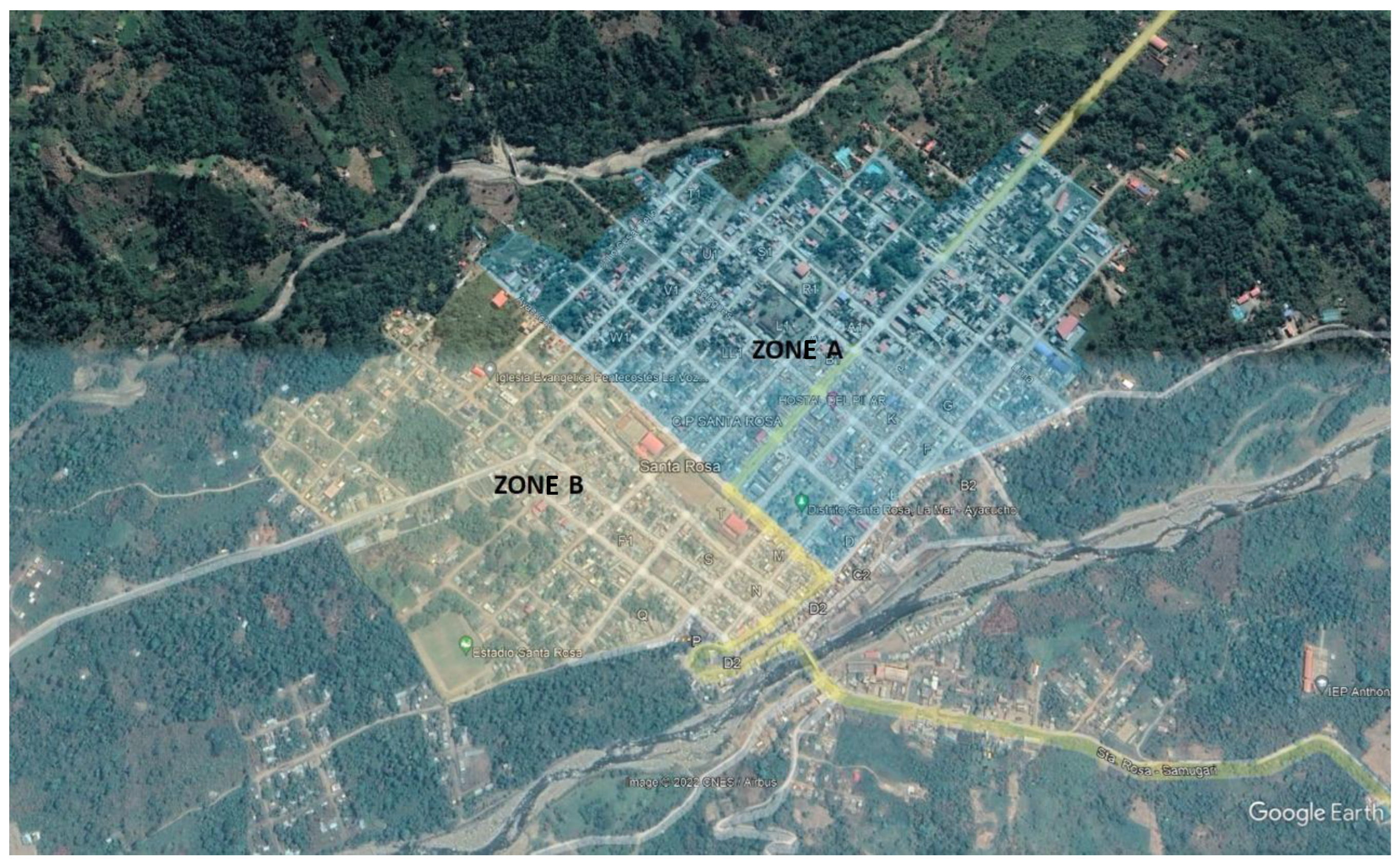
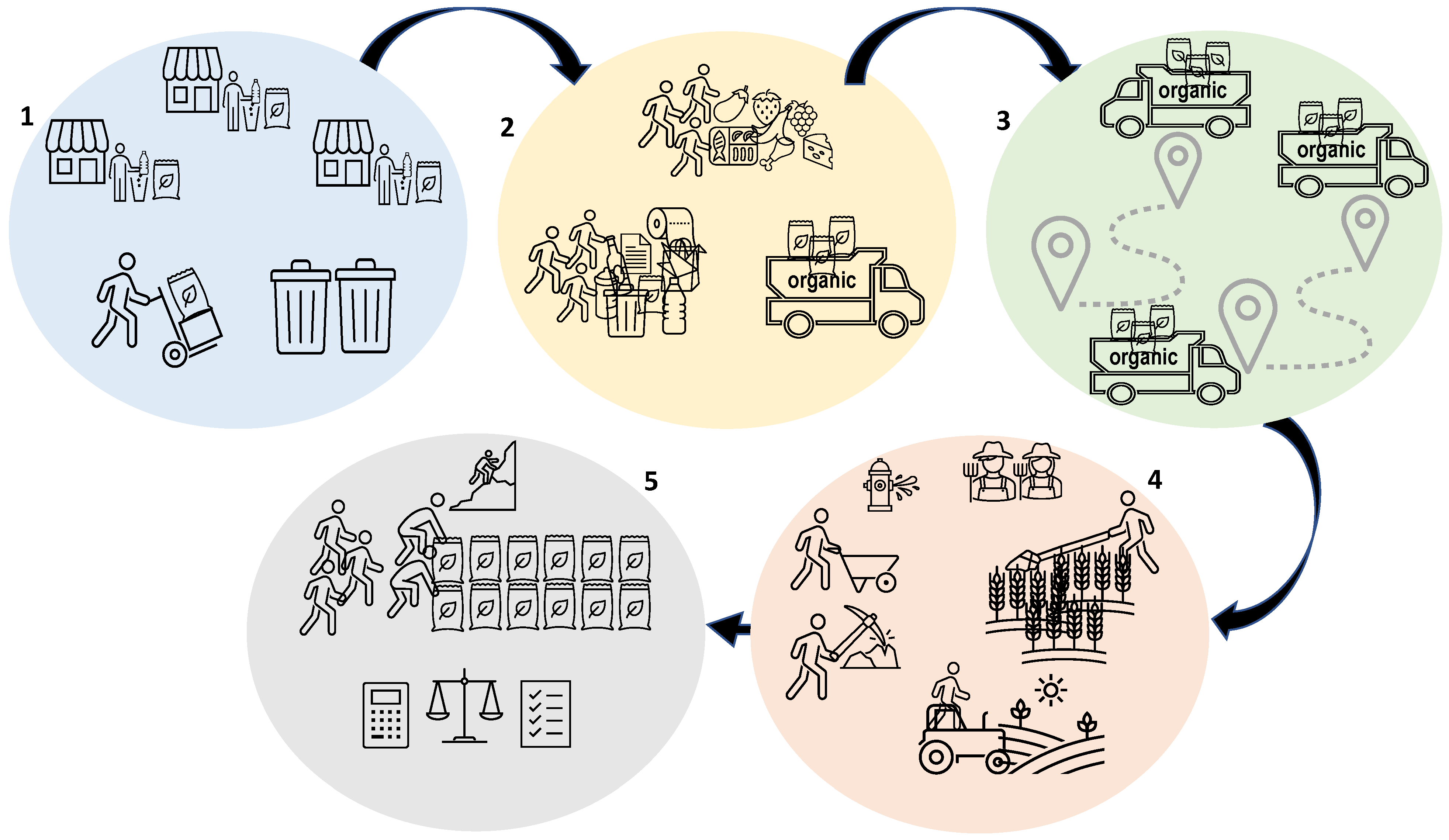
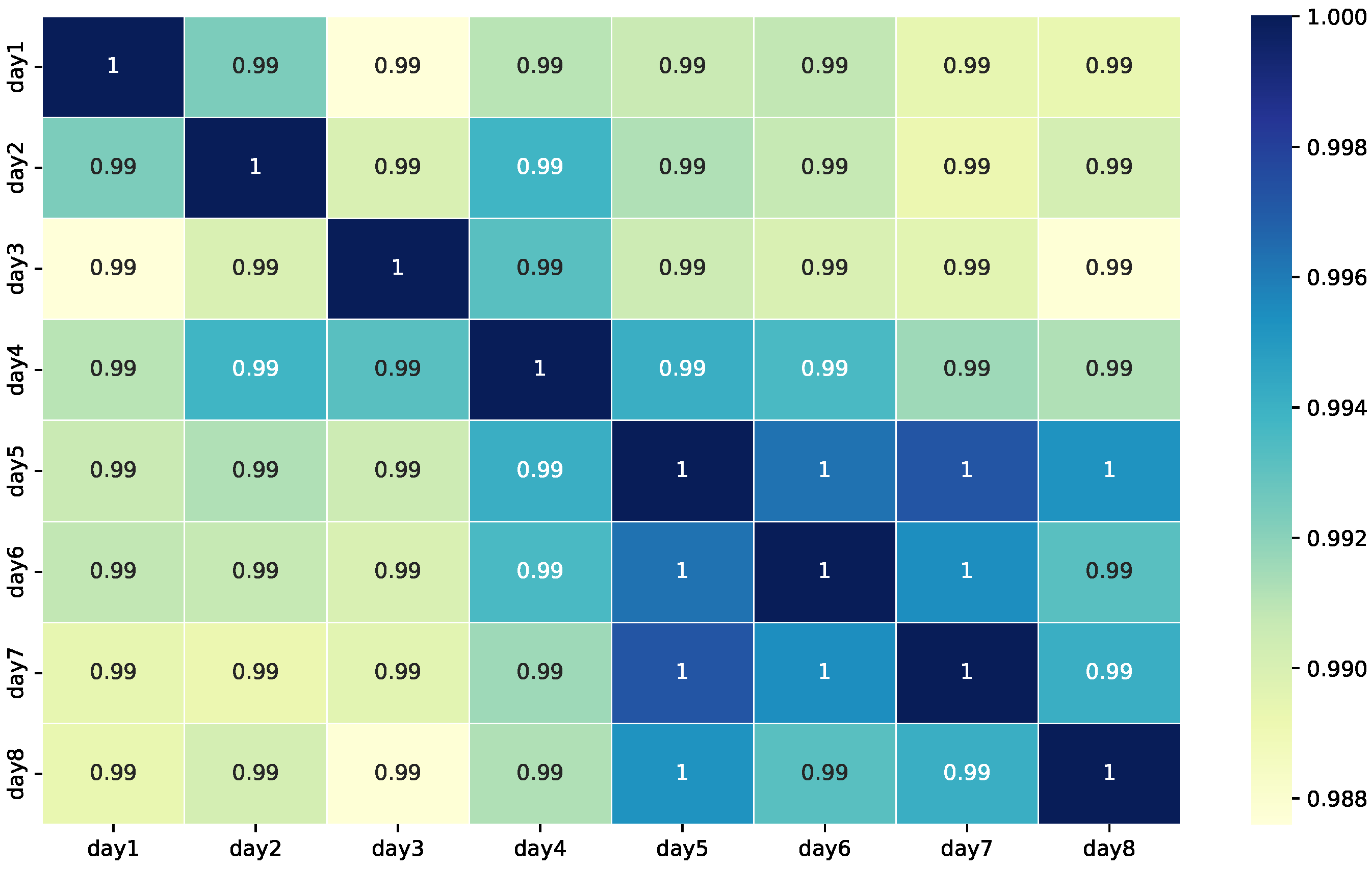

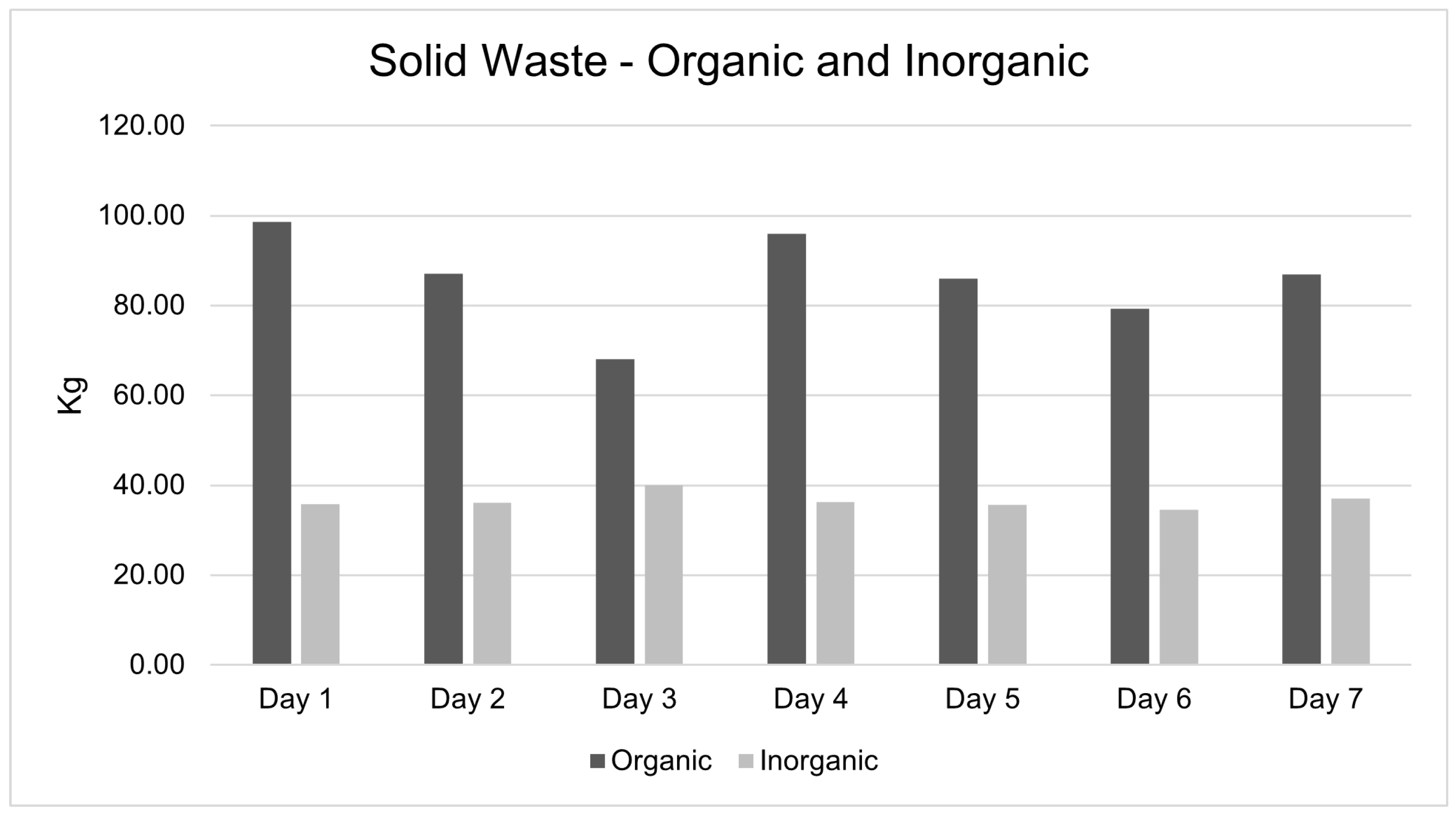
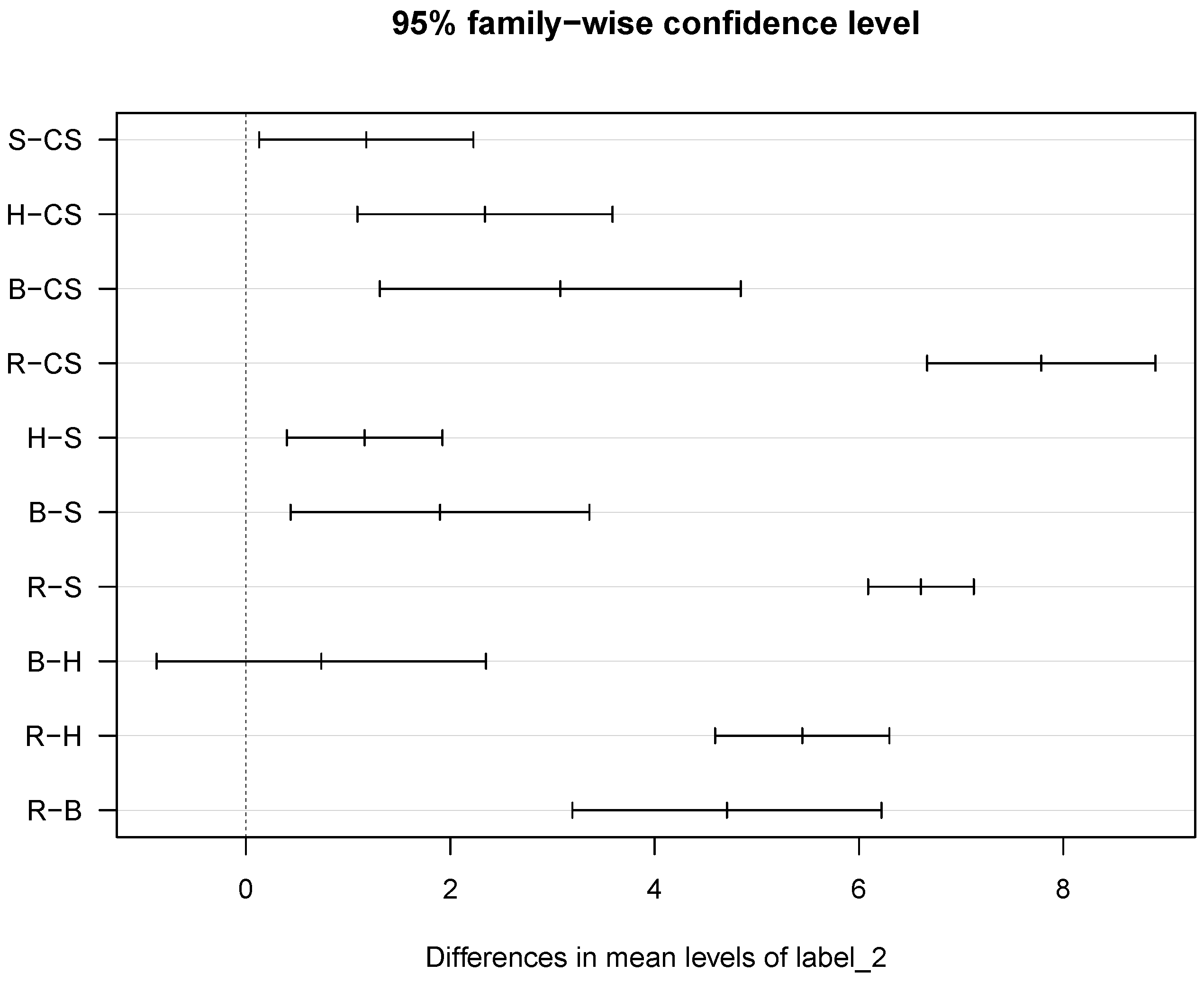
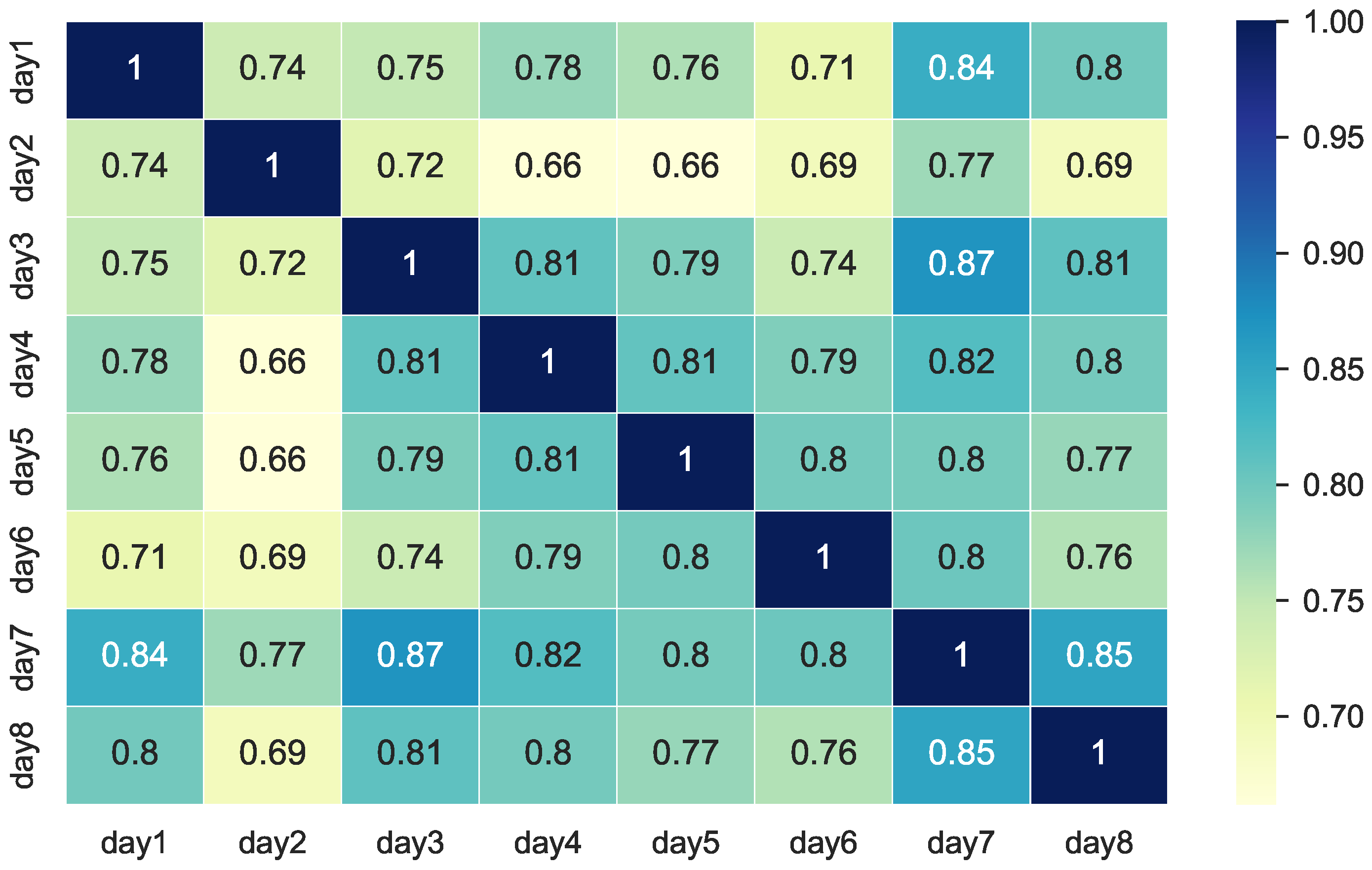
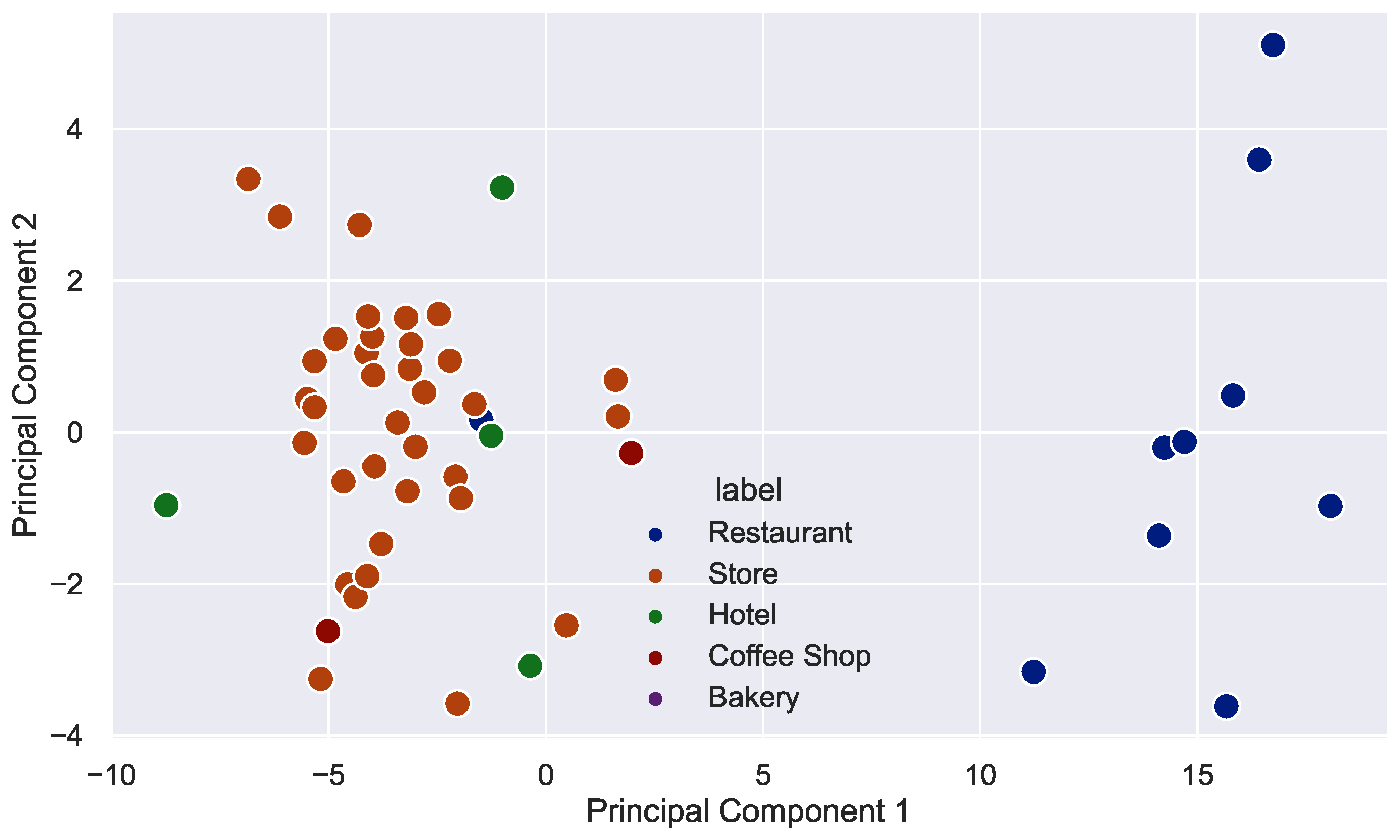

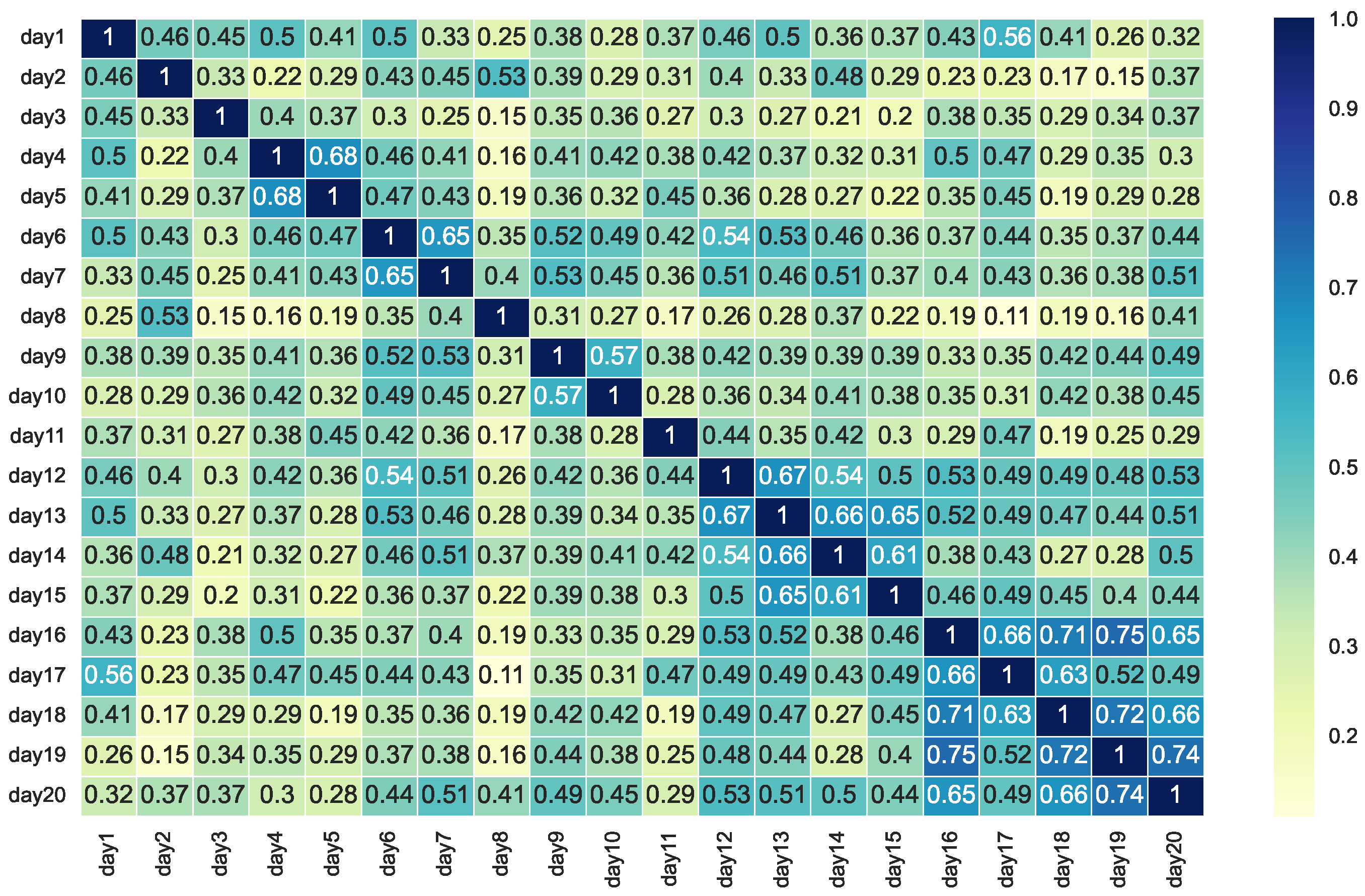
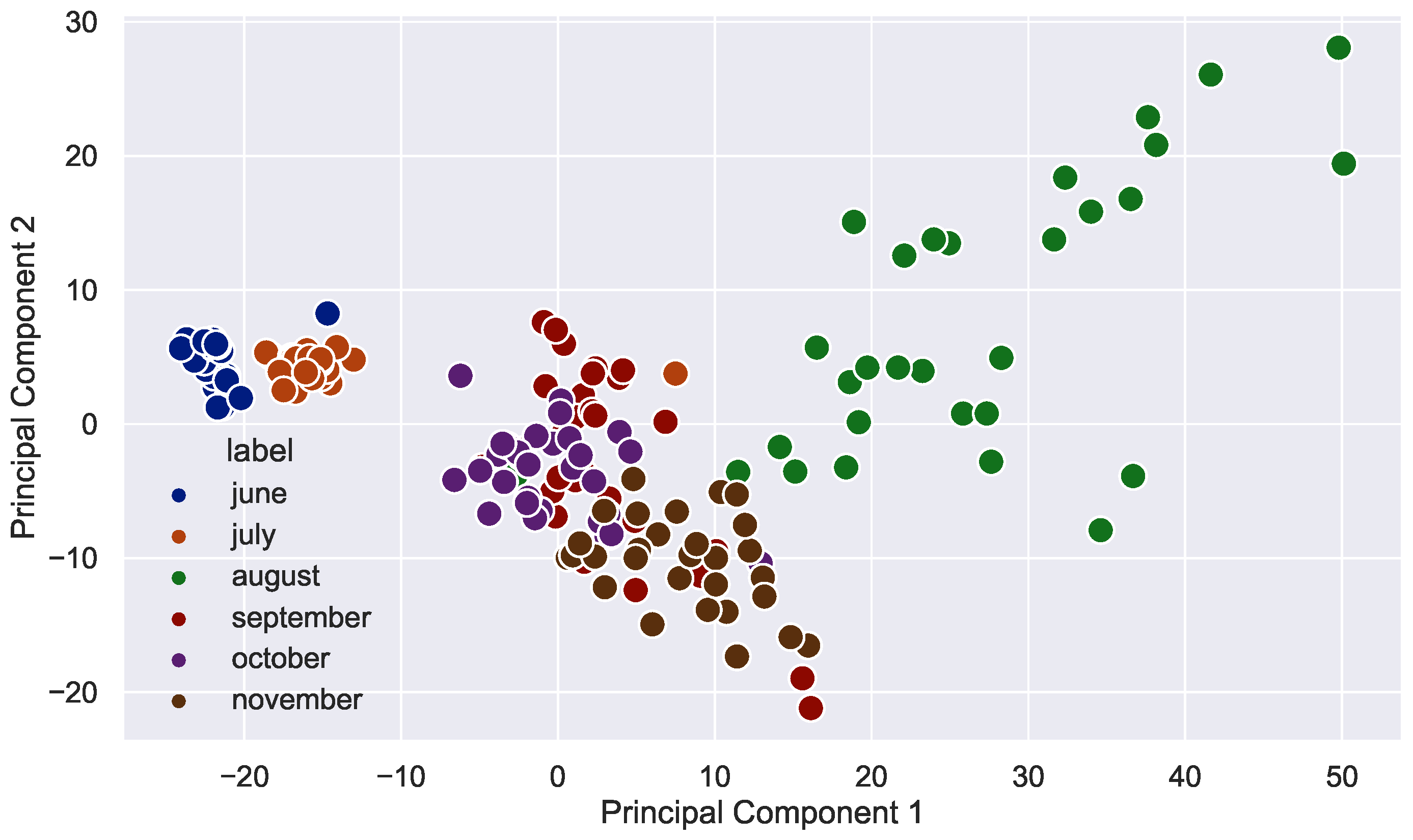
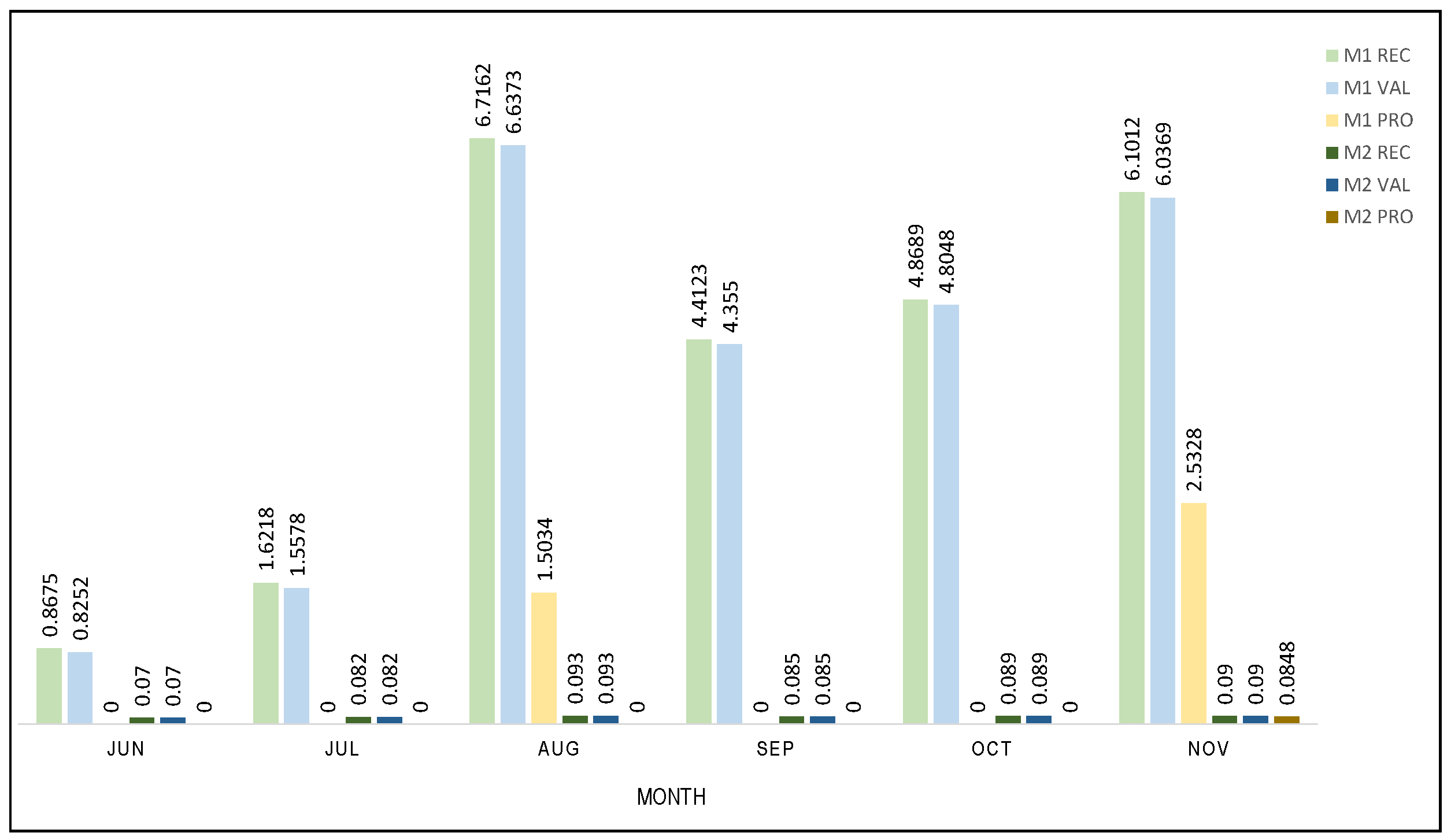
| Housing Range | Sample | CS | HS |
|---|---|---|---|
| Up to 500 homes | 45 | 9 | 54 |
| More than 500 and up to 1000 homes | 71 | 14 | 85 |
| More than 1000 and up to 5000 homes | 94 | 19 | 113 |
| More than 5000 and up to 10,000 homes | 95 | 19 | 114 |
| More than 10,000 homes | 96 | 19 | 115 |
| Df | Sum Sq | Mean Sq | F Value | Pr (>F) | |
|---|---|---|---|---|---|
| Days | 7 | 3.90 | 0.56 | 0.90 | 0.5091 |
| Groups | 1 | 0.71 | 0.71 | 1.14 | 0.2864 |
| Residuals | 567 | 352.72 | 0.62 |
| Df | Sum Sq | Mean Sq | F Value | Pr (>F) | R2 | |
|---|---|---|---|---|---|---|
| Days | 7 | 17.87 | 2.55 | 1.15 | 0.3296 | 0.7607 |
| Groups | 4 | 2826.64 | 706.66 | 319.00 | 0.0000 | |
| Residuals | 404 | 894.96 | 2.22 |
| Difference | Lower | Upper | p-Adjusted | |
|---|---|---|---|---|
| Store–Coffee Shop | 1.18 | 0.13 | 2.23 | 0.02 |
| Hotel–Coffee Shop | 2.34 | 1.09 | 3.59 | 0.00 |
| Bakery–Coffee Shop | 3.08 | 1.31 | 4.84 | 0.00 |
| Restaurant–Coffee Shop | 7.78 | 6.67 | 8.90 | 0.00 |
| Hotel–Store | 1.16 | 0.40 | 1.92 | 0.00 |
| Bakery–Store | 1.90 | 0.44 | 3.36 | 0.00 |
| Restaurant–Store | 6.61 | 6.09 | 7.12 | 0.00 |
| Bakery–Hotel | 0.74 | −0.87 | 2.35 | 0.72 |
| Restaurant–Hotel | 5.44 | 4.59 | 6.30 | 0.00 |
| Restaurant–Bakery | 4.71 | 3.20 | 6.22 | 0.00 |
| Df | Sum Sq | Mean Sq | F Value | Pr (>F) | Rs2 | |
|---|---|---|---|---|---|---|
| Days | 23 | 4181.55 | 181.81 | 9.40 | 0.0000 | 0.3926 |
| Months | 5 | 39,997.85 | 7999.57 | 413.45 | 0.0000 | |
| Residuals | 3811 | 73,736.08 | 19.35 |
| Difference | Lower | Upper | p-Adjusted | |
|---|---|---|---|---|
| July–June | 1.26 | 0.53 | 1.98 | 0.00 |
| October–June | 5.08 | 4.38 | 5.77 | 0.00 |
| September–June | 5.91 | 5.18 | 6.63 | 0.00 |
| November–June | 6.79 | 6.10 | 7.48 | 0.00 |
| August–June | 9.75 | 9.02 | 10.47 | 0.00 |
| October–July | 3.82 | 3.13 | 4.51 | 0.00 |
| September–July | 4.65 | 3.93 | 5.38 | 0.00 |
| November–July | 5.53 | 4.84 | 6.23 | 0.00 |
| August–July | 8.49 | 7.77 | 9.22 | 0.00 |
| September–October | 0.83 | 0.14 | 1.52 | 0.01 |
| November–October | 1.71 | 1.05 | 2.37 | 0.00 |
| August–October | 4.67 | 3.98 | 5.36 | 0.00 |
| November–September | 0.88 | 0.19 | 1.57 | 0.00 |
| August–September | 3.84 | 3.12 | 4.56 | 0.00 |
| August–November | 2.96 | 2.27 | 3.65 | 0.00 |
Disclaimer/Publisher’s Note: The statements, opinions and data contained in all publications are solely those of the individual author(s) and contributor(s) and not of MDPI and/or the editor(s). MDPI and/or the editor(s) disclaim responsibility for any injury to people or property resulting from any ideas, methods, instructions or products referred to in the content. |
© 2023 by the authors. Licensee MDPI, Basel, Switzerland. This article is an open access article distributed under the terms and conditions of the Creative Commons Attribution (CC BY) license (https://creativecommons.org/licenses/by/4.0/).
Share and Cite
Quispe, K.; Martínez, M.; da Costa, K.; Romero Giron, H.; Via y Rada Vittes, J.F.; Mantari Mincami, L.D.; Hadi Mohamed, M.M.; Huamán De La Cruz, A.R.; López-Gonzales, J.L. Solid Waste Management in Peru’s Cities: A Clustering Approach for an Andean District. Appl. Sci. 2023, 13, 1646. https://doi.org/10.3390/app13031646
Quispe K, Martínez M, da Costa K, Romero Giron H, Via y Rada Vittes JF, Mantari Mincami LD, Hadi Mohamed MM, Huamán De La Cruz AR, López-Gonzales JL. Solid Waste Management in Peru’s Cities: A Clustering Approach for an Andean District. Applied Sciences. 2023; 13(3):1646. https://doi.org/10.3390/app13031646
Chicago/Turabian StyleQuispe, Katherine, Mayra Martínez, Kleyton da Costa, Hilario Romero Giron, Jose Francisco Via y Rada Vittes, Lizet Doriela Mantari Mincami, Mohamed Mehdi Hadi Mohamed, Alex Rubén Huamán De La Cruz, and Javier Linkolk López-Gonzales. 2023. "Solid Waste Management in Peru’s Cities: A Clustering Approach for an Andean District" Applied Sciences 13, no. 3: 1646. https://doi.org/10.3390/app13031646
APA StyleQuispe, K., Martínez, M., da Costa, K., Romero Giron, H., Via y Rada Vittes, J. F., Mantari Mincami, L. D., Hadi Mohamed, M. M., Huamán De La Cruz, A. R., & López-Gonzales, J. L. (2023). Solid Waste Management in Peru’s Cities: A Clustering Approach for an Andean District. Applied Sciences, 13(3), 1646. https://doi.org/10.3390/app13031646








